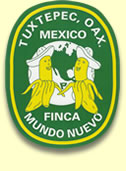
The difference between bananas and plantains is in the final destiny of the fruit and in some morphologic characteristics. The term banana is applied generally to the cultivates whose fruit eats fresh, and plantains to which are consumed cooked. The banana comes from the acuminata genome and the plantains from the genere balbisiana.
In the banana trees the fruit is smooth and less circular form in cross section; whereas the fruit of the plantain is from more mature and angular pulp.
The plantain in mature state is prepared fried, boiled, baked or roasted and in green state it is prepared fried, in form of puré (mashed) and 'tostones'.
At the moment at the Finca Mundo Nuevo, it is produced the plantain, with the same technology of handling es the banana, as they are packed, control of plagues and diseases, nutricional balance, packing, etc. In addition, the plantain, like the banana, is precooled and packed to it drained when it is destined to the export markets, since this cultivate maintains ethylene liberation in its transit and this way its natural process of maturation extends.
The plantain is a very important food in Mexican gastronomy, and is commercialized in the national market as foreign, in where the markets of the United States and Canada are the preferred.
Economic Importance of the Banana Harvest
The banana is the fourth more important harvest of the world, after the rice, the wheat and corn. In addition to being considered a basic product and for export, constituting an important source of jobs and income in numerous countries in development, as well as it is essential part of the daily diet for the habitants of more than one hundred tropical and subtropical countries.The Latin American countries and the Caribbean produces most of the bananas harvest that enter the international market, about 10 million tons, of the world-wide total of 12 million tons.
It is considered the main harvest of humid and warm regions of the Asian southwest.
Banana's Nutritional Value
It emphasizes his carbon hydrate content, reason why its caloric value is high. The most representative nutrients of the banana are the potassium, the magnesium, the fólic acid and substances of astringent action; without despising its high contribution of fiber. These last ones made it an appropriate fruit for those who suffers of diarreic processes. The potassium is a necessary mineral for the transmission and generation of nervous impulse and for the normal muscular activity, takes part inside in the balance of water and outside the cell. The magnesium is related to intestine function, nerves and muscles, part of bones and teeth, improve the immunity and have a smooth laxative effect. The folic acid takes part in the red and white globule production, in the genetic material synthesis and the antibodies formation of the immunological system. It contributes to deal with or to prevent anemia and bifid thorn in the pregnancy.In the following table it is presented the nutricional value of fresh banana based in 100 grams of eatable substance.
| Water (g) | 75.7 | |
| Proteins (g) | 1.1 | |
| Lipids (g) | 0.2 | |
| Carbohidrates | Total (g) | 22.2 |
| Fibers (g) | 0.6 | |
| Vitamins | A (UI) | 190 |
| B1 (mg) | 0.05 | |
| B2 (mg) | 0.06 | |
| B6 (mg) | 0.32 | |
| Nicotinic Acid (mg) | 0.6 | |
| Pantotenic Acid(mg) | 0.2 | |
| C (mg) | 10 | |
| Other Organic Components | Malic Acid (mg) | 500 |
| Citric Acid (mg) | 150 | |
| Mineral Salts | Oxalate (mg) | 6.4 |
| Sodium (mg) | 1 | |
| Potasium (mg) | 420 | |
| Calcium (mg) | 8 | |
| Magnesium (mg) | 31 | |
| Manganese (mg) | 0.64 | |
| Iron (mg) | 0.7 | |
| Copper (mg) | 0.2 | |
| Phosphorus (mg) | 28 | |
| Sulfur (mg) | 12 | |
| Chlorine (mg) | 125 | |
| Caloríes (kcal) | 85 |
How to Select and Conserve
They always have to be intact, without blows nor bruises. As much in the banana as in the plantain of crude consumption, the color of the skin is indicative of the degree of maturity of the fruit. It had to discard the units that are excessively soft. The presence of spots and black or brown points in the skin does not affect the quality of the piece.This fruit does not require special conditions of conservation, is enough to maintain them in a fresh, dry place and protected of the direct light of the sun. If they are conserved in the refrigerator, the rind of the banana is blackened so its external aspect is altered, but this absolutely does not affect its nutritious quality. The darkening of the skin can be avoided if they become involved in newspaper paper.

© Copyright 2007 - Finca Mundo Nuevo. All Rights Reserved.

